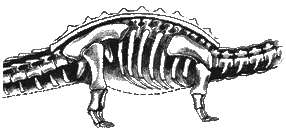
The Turtosaur, Turotosaurus armatus, is an bizarre, armored eutitanosaur from the grasslands of the Pampas, in The New Dinosaurs: An Alternative Evolution. It is likely descended from Saltasaurus.
South America has had an interesting history. After it had broken away from the ancestral supercontinent of Pangaea it remained an island continent for most of its life. It connected only occasionally to the continent of North America in the north, as it is today. At the end of the Cretaceous period the hadrosaurs spread over most of the continents and established themselves as the principal large herbivores, replacing the great four-footed sauropods. The sauropods still exist, but mostly in places where the hadrosaurs never gained a foothold, such as the South American continent. Isolated from the influences of migration from other continents, the sauropods evolved in their own way.
The titanosaur group - the only surviving clade of sauropods - had begun to develop armor as early as the Late Cretaceous period. They continued to do so in South America and, in the Pliocene, with the arrival of the new meat-eaters during the Great American Interchange, the armor developed into very flamboyant and spectacular forms. The turtos

The armor of the turtosaur is formed from bone masses that grow in the skin and are covered by a layer of horn. The back armor is a solid mosaic of small skin bones, with much larger bones spread between them. These larger bones provide the bases for a series of conical spikes. Huge hip bones and shoulder bones support the weight. There is no armor on the legs or the underside of the tail. When danger threatens the animal flops down on its belly and presents an impenetrable shield of bone and horn to its enemy.
aur has a solid shield of armor over its back and flanks. The tail and neck are also shielded, the tail by overlapping rings of horn, and the neck by jointed horn sections. The head is covered with a continuous horny shield. The jaws have no teeth, but the mouth edges of the horn shield are sharp and are ideal for cropping grass.
